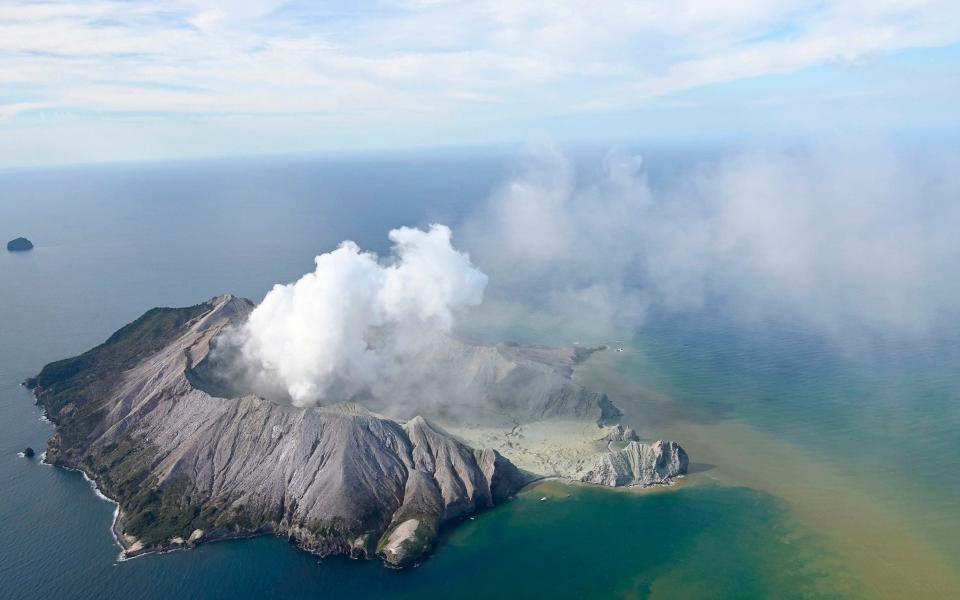New Zealand volcano: 'No signs of life' as at least five are killed in White Island eruption

New Zealand authorities do not expect to find any more survivors after a volcanic eruption on Monday killed at least five people with more than twenty still missing.
It is thought there were about 50 people on White Island, 30 miles off the east coast of the country's North Island, when the volcano erupted on at 2.11pm local time on Monday spewing an enormous plume of ash into the air.
Several people, New Zealanders and a number of foreign tourists, were seen walking inside the rim of the volcano minutes before the eruption.
Rescue helicopters and other aircraft undertook a number of aerial reconnaissance flights over the island after the eruption and detected no signs of life.
New Zealand Police said that they believe "anyone who could have been taken from the island alive was rescued at the time of the evacuation".
"Based on the information we have, we do not believe there are any survivors on the island," police said in a statement.
My god, White Island volcano in New Zealand erupted today for first time since 2001. My family and I had gotten off it 20 minutes before, were waiting at our boat about to leave when we saw it. Boat ride home tending to people our boat rescued was indescribable. #whiteislandpic.twitter.com/QJwWi12Tvt
— Michael Schade (@sch) December 9, 2019
Late Monday night the island was still too dangerous for authorities to send rescue crews. New Zealand Police are now working urgently to confirm the exact number of those who have died.
A New Zealand Defence Force ship will approach the perimeter of the island at first light on Tuesday to deploy drones and other observational equipment to assess the environment. After the eruption falling ash hampered rescue efforts.
Twenty three people were successfully evacuated, five of whom later died while a number of survivors suffered severe burns.
What we know so far
Five people confirmed dead
At least 18 treated for injuries
At least 10 people remain missing
No sign of life detected by helicopter
Island too dangerous for rescue attempts
Volcano erupted just after 2.10pm local time
Ash plume reached 12,000ft (3,657m)
White Island is New Zealand's most active volcano
New Zealand police initially thought about 100 people were on the island at the time, but later revised that estimate to fifty.
The eruption began at 2.11pm local time (0111 GMT).
Tourist Michael Schade, who was on board a boat leaving the island after a morning tour, filmed a thick plume of ash and smoke as the volcano erupted.
"My god," he wrote on Twitter as he posted video of the eruption.
"My family and I had gotten off it 20 minutes before, were waiting at our boat about to leave when we saw it. Boat ride home tending to people our boat rescued was indescribable."
His video showed a wall of ash and steam around the island and a helicopter badly damaged and covered in ash. He said one woman was badly injured but seemed "strong" by the end.
It is understood that between 30 to 38 people were visitors from the Standing Ovation cruise ship from the Royal Caribbean company.
It is believed that at least 20 of the cruise guests on the island at the time of the eruption are from Australia.
"Australians have been caught up in this terrible event and we are working to determine their wellbeing," Australian Prime Minister Scott Morrison said.
Brad Scott, a volcanologist with research group GNS Science, said the eruption sent a plume of steam and ash about 12,000 feet (3,660 metres) into the air.
He said it had also affected the whole of the White Island crater floor. The GeoNet agency, which monitors volcanoes and earthquakes in New Zealand, raised the alert level on White Island from one to two on Nov 18, noting an increase in the amount of sulfur dioxide gas, which originates from magma deep in the volcano.
It also said at the time that over the previous weeks, the volcanic tremor had increased from weak to moderate strength.
Mr Scott said the alert level was often raised and then later dropped again without any eruption. He said there hadn't been any major incidents with tourists visiting the island in the past, although there had been some close calls.
Professor Mike Burton, Chair in Volcanology at the University of Manchester, told The Telegraph that one of the major challenges in visiting an active volcano like White Island is that "even a small explosion can be quite hazardous because people are standing in a position which is very close to where the eruptions can occur".
Those are some of the people put boat picked up. Praying for them and their recovery. Woman my mom tended to was in critical condition but seemed strong by the end.
The helicopters on the island looked destroyed: pic.twitter.com/jds5QBD1yg— Michael Schade (@sch) December 9, 2019
Professor Burton said a key question is "to either restrict access completely or not".
"Approximately 10,000 people have visited White Island every year and so it is a very popular destination and a fascinating place to visit. Local volcano monitoring by GNS had detected signs of increased SO2 degassing prior to the eruption, but this can also occur without producing explosions," he said.
Late Monday afternoon New Zealand Prime Minister Jacinda Ardern said: "I know there will be a huge amount of concern and anxiety for those who have loved ones at the island at that time. I can assure them police are doing everything they can."
White Island, in the Bay of Plenty, is the most active volcano in New Zealand.
While there are many historically volcanic regions in New Zealand, since the 1850s volcanic activity in the country has been in only two zones, the Taupo Volcanic Zone – where White Island is located, and the Kermadec Arc.

 Yahoo News
Yahoo News 